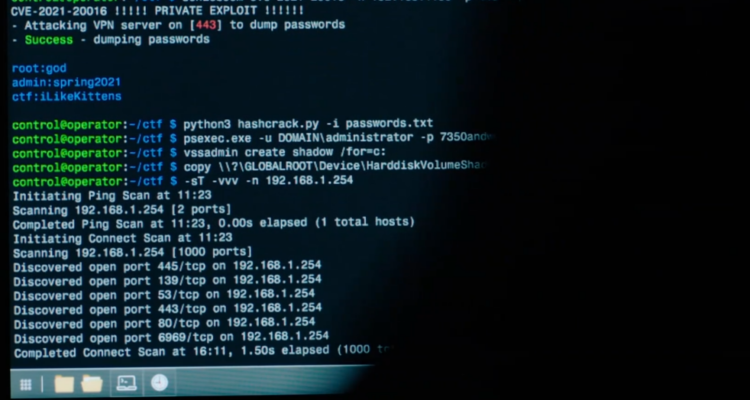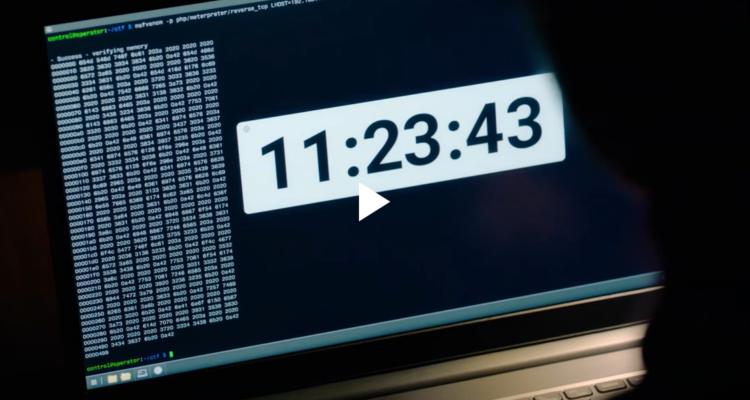Channel 4’s “The Undeclared War” is a TV Show about a third-party country undermining UK democracy by disrupting UK networks through cyber-attacks. The protagonist is an intern who has a front-row seat to the ordeal and the show is set inside GCHQ, at least that is what I have seen from the first two episodes. I’ll write up more when they are released.
Here is a breakdown of all of the techniques used in the show. It is clear the writers took at least some inspiration from actual real-world scenarios but then bent the rules or changed some aspects to fit the narrative of the episode, which makes the episode a little hard to watch.
The Undeclared War is an inside look at an attack on British internet infrastructure and the inner workings of GCHQ.
The Undeclared War Episode 1
The episode starts out in a fairground, analogous to hacking, as becomes clear when shots of Saara (main character) are interspersed with her sitting in a classroom playing against other hackers.
This is a reference to a game in hacker culture called a CTF or Capture the Flag. A Capture the Flag (CTF) is a popular way of introducing or testing a hacker’s ability, so in that sense at least the show got it right! CTFs are usually a social event and often very competitive, a good start to the first episode.
There are also some more references for the keen viewer, at one point Saara pulls out a hammer and starts knocking on bricks on a wall, this is similar to port knocking, a technique of security through obscurity whereby a system will not open a port to allow access to an application without first having a client send packets to a network connected device in a specific sequence across various port numbers.
After Saara is done knocking the bricks with a hammer, she is able to remove a brick (or the system opens a port) to view the valuable information inside.
It’s not clear how Saara would know the pattern in order to hit the bricks but is possibly something that she would have to capture using packet sniffing or know by other means, such as accessing the computer she is targeting using command line tools such as SSH or even remote desktop.

The show then cuts back to the real world out of the analogy briefly to show the commands Saara is running on her screen, we can see a lot going on but we see references to meterpreter.exe at the top.
Meterpreter is a penetration tool used to exploit programs in order to allow a hacker access to a system remotely, which we can see she has used it to dump the password hashes, but in this version of the tool meterpreter has been able to also decrypt the hashes and displays them on screen before she’s cracked them.
Despite this, she then runs a python3 program (python being a popular programming language) to run a program called hashcrack.py which takes a passwords.txt file as input probably to crack the hashes, to nitpick it looks like they’ve already been cracked, but perhaps she didn’t have all of the hashes yet.
Python also isn’t a particularly fast language for cracking passwords, a more direct access to the hardware is usually preferred so that the hashes can be computed quicker. Cracking hashes could take days to decades if the password is complex, so every minute advantage in performance counts.
Saara then at the end of the cutscene she runs the command -sT -vvv -n 192.158.1.254 which seems to be a bit of fat-fingering by Saara, because it’s supposed to be part of the line above or nmap, but the computer doesn’t seem to mind and dutifully executes the command as though nothing is wrong.
The whole time she seems to be switching between Linux and Windows commands arbitrarily and the computer doesn’t seem to mind, she never switches context from windows or Linux, the commands she entered don’t really make any sense throughout the episode in terms of what is actually possible on one operating system.
We can also see a CVE at the top of the screen, CVE’s are critical vulnerability notices used in various ways to identify and classify exploits in computer programs, it doesn’t really make sense that this would be labelled a “private exploit”, because it’s public by design.

She then also tried to take a copy of the windows box using volume shadow copy, a tool for taking a form of backup, she then decides its time to scan for some open ports, it looks like the command -sT -vvv -n 192.158.1.254 is actually nmap, a port scanning tool, not that she actually runs nmap, it just outputs text extremely similar to it.
We can see that nmap lists the following open ports 445, 139, 53, 443, 80, 6969. 445 and 443 could possibly be SMB or file shares, or a webserver as we can see port 80 is also open, port 53 is for DNS so this box is perhaps also a DNS server, and port 6969 is I’m sure also a real thing, although my skills are lacking a bit when it comes to what this port is for, I don’t think its a real thing but actually a joke for the informed (or otherwise) viewer.
Saara spends the rest of the scene walking around with a tool belt on, clearly focused on the task at hand.
Then she is seen using various commands in the terminal, which are mostly nonsense, but it doesn’t complain at all. Clearly, the directors have turned off the output of the command line if the user types out an erroneous command.

At one point a timer pops up, we can see she runs the command msfvenom which prints out some hex. Cool, but even some of the best hackers in the world don’t spend their time reading hex, its like reading a barcode or serial number, it may make sense to computers, but without some real context and understanding of what is going on, its useless to humans.

Working at GCHQ
In the next hackery-type scenes we see, Saara has learned of the attack and starts looking at the code in a program called IDA at about 16 minutes in.

She spends some time scrolling around the code and at one point finds a lot of “garbage” a good way of showing that often tasks like this are tedious and hard to follow. When a compiler compiles a program it strips it of any human-readable comments or friendly function names that are easy to follow, so its often a lot of scrolling, annotating and scrolling to determine what the program does.
This part is a little bit confusing because she is able to identify “garbage” but isn’t able to tell that the code has been obfuscated, obfuscation is a way to make code harder to reverse engineer by having the program perform its function with extra complexity. Saara’s overseer calls the program “some FinFisher thing”, which isn’t really a method for obfuscation but whatever, perhaps I am misinterpreting what he is saying.
Interestingly the malware is also called Suspected_Malware.exe in IDA but later called SUSPECTED-MALWARE.exe in the sandbox.
The IDA freeware program allows you to read the program as machine code, somehow Saara doesn’t notice that the program is written to never run the functions or “garbage” she is looking at, despite the fact IDA would have clearly annotated this.
The software reverser Phill says that the garbage is to “confuse the look of the code so the antivirus software won’t recognise it as malware” which sort of makes sense, what he means is that it will change the signature of the program so the antivirus would not be able to detect the program as a known signature or the program behaviours are different than what the antivirus is designed to detect. Again, something Saara would probably know.
She is offered the opportunity to use their test environment, where she incorrectly corrects him about calling it a sandbox.
When she actually runs the program in the sandbox, it errors out and says it can’t run, which the reversing engineer (Phill) says to try to emulate actual user behaviour to see if you can trick it into running, but this is bad advice because they can just reverse the program to determine what is stopping the program from running!
Again, something Saara should understand and already know. “Paste in some word documents, scroll around a bit” lol, once again they have IDA so would be able to determine exactly what is required to cause this behaviour,
Imagine you are reading a book, but you don’t have time to read all of it, and you really just want to know why the main character’s favourite colour is red, you know that on page 20 they say their favourite colour is red, if we try to shoe-horn IDA into this analogy, we would get a direct reference to where the character grew up with a red front door, and that is why their favourite colour is red.
Programs need references in the code to establish behaviours, so when it throws up an error, they can just look through the code, find the error in the code, and trace it back to determine what caused the program to realise it was in a sandbox and prevent it from running, this is basic usage for IDA, its what it is designed to do.
Trying to “Paste in some word documents, scroll around a bit” is like trying to mow a lawn with scissors when you have a lawnmower, ineffective and poor use of the tooling they have.
Its also very unlikely an intern would be vetted enough to have this level of access.
Fear of Attribution
At one point, Danny (Simon Pegg) is reluctant to assign attribution of the malware, this is generally a good call, because it is a technique that advanced persistent threats would use, to implant false clues to assign attribution to a different adversary to throw off investigators. The show talks about Russian bots as well, a real-world issue.
Danny also is chastised for running stressing infrastructure against the network, running this type of test against a production environment during peak hours is a terrible idea.
The hack is also able to take down some parts of the web but leaves others up, this is odd, it may be technically possible however practically all of these systems will themselves have both redundancy and disaster recovery to bring the systems back online, especially products with SLA agreements with their customers.
Many of these systems would be hosted in clouds like AWS or Azure and generally have mechanisms built-in to prevent a global outage based on a single point of failure like a country going down, if a BGP route went down, for example it would not take too long before everything would be re-established through a new route.
Reversing Libraries
At around 28 minutes in, Phill laughs as Saara has reverse-engineered a library saying that “we’ve all done it”, but practically it is almost certainly a good idea, you can probably determine that a program is using a library and probably even check it against a known hash of the library.
The department missing this crucial part of the code by not looking is negligent and certainly something they would have done. They are looking for exactly what she has found, they aren’t looking for something else, so it is odd that they would discount her abilities, its a team effort.
The program opens a URL shortner link https://url.short/41e which isn’t a valid top level domain name, to run some code, which could run anything.
With that, it’s off to a cobra meeting they go.
